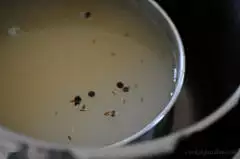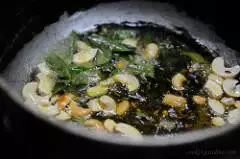Ven pongal or Khara pongal is not something I grew up eating. It is a popular South Indian dish made with rice and yellow moong dal, and typically flavoured with black pepper, cumin, ginger, and ghee. It’s often served as a breakfast dish and during Pongal festival. Since being married to a Tamilian who is not really a pongal fan, I rarely make pongal at home but it does make for a creamy, delicious treat on rare occasions, for myself.
My MIL makes a mean ven pongal and I have taken a few tips and tricks from her to make sure we novices can also get good results when making pongal in our kitchens.
About Ven Pongal
Ven pongal is a soft cooked mash up of raw rice and yellow moong dal (lentils) with extra water to give it a creamy texture. It is a popular breakfast or festival dish in Tamil Nadu and is typically seasoned with black pepper and cumin, and garnished with ghee. Ven Pongal has a creamy and soft texture, and it is often served with coconut chutney and sambar or a delicious side dish called Gotsu.
Key Ingredients
Ven pongal made by cooking rice and split yellow moong dal together, usually in a pressure cooker, until they become soft and mushy. The tempering or tadka is an important step in making Ven Pongal, as it adds flavour to the dish. The tempering usually includes ingredients like black pepper, cumin seeds, ginger, curry leaves, and asafoetida, which are sautéed in ghee before being added to the soft cooked rice and dal.
There are a few variations in ven pongal recipe depending on each household and the flavour can change quite a bit depending on the proportions of each of the basic ingredients, which usually remain the same.
Ven pongal and Pongal festival
Ven Pongal is commonly prepared during the Pongal festival in Tamil Nadu, a harvest festival celebrated in January. Due to this, the “new rice” is made to cook pongal. However, Pongal can certainly be enjoyed throughout the year as a filling and comforting meal. The dish is known for its simplicity, yet it’s delicious and satisfying and many who live away from home crave a good hot plate of Pongal on rainy days.
Tips to make pongal
- Rice to Lentil Ratio: A common ratio is 1:1, but you can adjust it based on your preference. We prefer prefer a higher proportion of rice for a softer texture, so you will find I have used 1 cup rice for 1/2 cup moong dal
- Rinsing: Always rinse the rice and lentils thoroughly before cooking, to remove excess starch. This helps in achieving a fluffy and soft texture.
- Type of Rice for Pongal: Traditionally, short-grain rice like raw sona masuri is used for making Pongal. You can use raw ponni rice too with good results. Remember to choose raw rice vs par-boiled rice while shopping for ingredients to make pongal
- Tempering or tadka: The tempering adds a lot of flavor to Pongal, which is otherwise quite a bland combination of rice and lentils. Use fresh ingredients like whole black pepper, cumin seeds, grated ginger, and curry leaves. The roasting of these spices in ghee enhances the overall taste.
- Ghee: Don’t skimp on ghee, this is important. Adding a generous amount of ghee not only enhances the flavour but also gives a rich and creamy texture to the Pongal. I typically use homemade ghee but store-bought ghee absolutely works fine too
- Asafoetida or Hing: Asafoetida is an important ingredient in the tempering, as is the case for most TamilNadu recipes. It adds a unique flavour to the dish.
- Cashews: For me, there’s no pongal without some golden roasted cashewnuts to bite into but I will say this is optional, in case you are allergic or prefer not to use them
- Consistency: Adjust the final consistency after cooking the rice and lentils by adding more hot water. The Pongal should be creamy and not too dry. I have also seen hot milk being added to increase the softness of potentially dry pongal.
- Serve Hot: Pongal is best enjoyed when it’s freshly made and hot. Serve it immediately after preparation.
- Accompaniments: Pongal pairs well with coconut chutney, sambar, kathirikai gotsu or even a simple side of yogurt and pickle as my husband likes it.
I know that seems like a lot but making Pongal is a straightforward process, and these tips can help you achieve a delicious end result, especially if you are new to cooking pongal. Adjust the ingredients and proportions to suit your preferences, as always.
Ven Pongal Recipe
Ingredients
- 1 cup raw rice not par-boiled rice
- 1/2 cup split yellow moong dal paasi paruppu
- 1/2 tsp whole black pepper adjust to taste
- 1/2 tsp cumin seeds jeera
- 1 tsp ginger minced
For Tempering
- 1/2 tsp cumin seeds
- 1/2 tsp black pepper
- 1/4 cup cashew nuts
- A few curry leaves
- 1/4 tsp asafoetida hing or perungaayam
- 3 tbsp ghee
- 2 tbsp oil or just use more ghee
Instructions
- Rinse 1/2 cup split yellow moong dal until water runs clear and soak for 30 minutes
- Wash 1 cup raw rice and add the soaked dal to this along with 3 cups water
- Place in a bowl in a pressure cooker with water. You can also cook it directly in the pressure cooker but we usually do it this way.
- Add 1/2 tsp whole black pepper and 1/2 tsp cumin seeds to this along with 1 tsp ginger minced
- Cook for 4 whistles or 15-20 minutes. The rice and dal should be cooked and very soft. Keep aside.
- Powder or crush together 1/2 tsp cumin seeds and 1/2 tsp black pepper for tempering. Keep aside.
- Heat 2 tbsp oil or ghee in a large pan and add 1/4 cup cashew nuts.
- When they turn a light golden brown, add 1/4 tsp asafoetida, the powdered cumin and pepper, and A few curry leaves
- Roast well and add the cooked rice and dal mixture to this
- Add salt and top up with 3 tbsp ghee (or more as needed) and mix well to combine fully
- Serve immediately
Step by Step Ven Pongal Recipe
Soak washed moong dal for 30 minutes
Wash the rice and add the soaked dal to this along with 3 cups water. Place in a bowl in a pressure cooker with water. You can also cook it directly in the pressure cooker.
Cook for 4 whistles or 15-20 mins until the dal-rice mixture is soft and mushy.
Powder the cumin seeds and pepper under “tempering ingredients” together
Heat oil (or just use ghee) and add the cashew nuts. Once they are golden brown, add all other ingredients to temper.
Roast well.
Turn off heat and add the cooked rice-dal mixture to this.
Mix everything well with salt and add more hot water if the pongal is too try.
Serve ven pongal hot!








Made this today since it is pongal festival obviously. Love it. I usually used to add turmeric powder while boiling the rice and dal mixture. I have added the salt to the mixture to get a more even mix. Thank you.
Thanks nags… That kozhumbu looks delectable. I love the color and the texture too. I had made kozhumbu in the past with either onions or sundrakkai vatthal. Do you have any posts on how to cook using the various vatthals. I am in Kerala and can find them in some shops sometimes.
vatral may not be too popular in Kerala because it is a Tamil food ingredient. Try a few stores, they may stock it. We get ours from relatives and family in Tamil nadu 🙂
I made brinjal sambar with pongal for Pongal this year. What is the kind of accompaniment in your photo? Is it onion sambar? To me it has the color of kozhumbu, which always makes me hungry. What is the recipe for the accompaniment here?
Great questions! The kozhambu you see with my pongal up there is shallot (chinna vengaayam) kozhambu which my MIL makes with a little coconut milk. It is her own recipe which I haven’t shared yet, incidentally. Gotsu is the more popular accompaniment with pongal but since I am not a Tamilian, I rarely make it! It is much simpler than any kozhambu in terms of preparation time and difficulty.
Hi Nags! Thanks for the timely post! The mister wanted to make pongal, and thanks to your post, he did. (The step by step photos helped a lot as well)..we had ours with chutney, was fab!
Pongal happens to be my daughter’s fave .. I have not tried it myself though .. this is what she eats every weekend at Sarvana Bhavan 😀 .. i think its high-time i try and tell you how it goes ..
Happy Pongal to you and the hubby! I can see the pepper kick in your mom’s pongal. My favorite combo is coconut chutney and kathirikkai gothsu. That is what is coming up this sunday at our place..of course all that because my mom is here!
I feel like having two cups of this ven pongal and sambar now! Craving for something heavy like this 🙂 perfect recipe for the festive time!